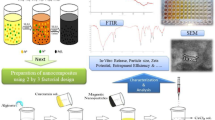Abstract
The last century, more precisely after 1945, was marked by major advances in the treatment of infectious diseases which promoted a decrease in mortality and morbidity. Despite these advances, currently the development of antimicrobial resistance has been growing drastically and therefore there is a pressing need to search for new compounds. Silver nanoparticles (AgNps) have been demonstrating good antimicrobial activity against different bacteria, viruses, and fungi. Curcumin (CUR) extracted from rhizomes of Curcuma longa has a variety of applications including antiinflammatory, antioxidant, and antibacterial agent. The association between silver nanoparticles and curcumin in a formulation can be a good alternative to control infectious diseases due the antimicrobial properties of both compounds. The objective of this work was to develop a formulation composed of a thermoresponsive gel—with antimicrobial and antioxidant properties due to the association of AgNps with PVP and PVA polymers. After AgNp synthesis, these were incorporated together with the previously prepared CUR/P407 (1:2) solid dispersion (SD) into a polymer dispersion of 20% P407 (thermosensitive gel). Our results showed that the association between the AgNps with CUR SD demonstrated good antioxidant activity as compared to the standard compound. Measures of MIC showed more efficacy against Gram-negative bacteria (Escherichia coli and Pseudomonas aeruginosa) than for Gram-positive bacteria (Staphylococcus aureus). This association enhances antimicrobial activity against E. coli and P aeruginosa and added antioxidant value in formulations.



Similar content being viewed by others
References
Alanis A. Resistance to antibiotics: are in the post-antibiotics era? Arch Med Res. 2005;36:697–705.
Organização Mundial de Saúde WHO, 04/2014 disponível em: http://www.who.int/mediacentre/news/releases/2014/amr-report/en/.
Santos CA, Seckler MM, Ingle A, Gupta I, Galdieiro S, Galdieiro M, et al. Silver nanoparticles: therapeutical uses, toxicity and safety issues. J Pharm Sci. 2014;103(7):1931–44.
Rai M, Pandit R, Gaikwad S, Yadav A, Gade A. Potential applications of curcumin and curcumin nanoparticles: from traditional therapeutics to modern nanomedicine. Nanotechnol Rev. 2015: 1437–4315. doi: 10.1515/hsz-2015-0001.
Raman T, Ramar M, Arumugam M, Navabi SM, Kumaraswamy M, Varsha N. Cytoprotective mechanism of action of curcumin against cataract. Pharmacol Rep. 2015;68(3):561–9. doi:10.1016/j.pharep.2015.12.012.
Kali A, Bhuvaneshwar D, Charles P, Seetha KS. Antibacterial synergy of curcumin with antibioticsagainst biofilm producing clinical bacterial isolates. J Basic Clin Pharmacol. 2016;7:93–6.
Tyagi P, Singh M, Kumari H, Kumari A, Mukhopadhyay K. Bactericidal activity of curcumin I is associated with damaging of bacterial membrane. PLoS One. 2015;10(3):e0121313. doi:10.1371/journal.pone.0121313.
Betts JW, Sharili AS, Ragione RM, Wareham DW. In vitro antibacterial activity of curcumin–polymyxin B combinations against multidrug-resistant bacteria associated with traumatic wound infections. J Nat Prod. 2016;79(6):1702–6. doi:10.1021/acs.jnatprod.6b00286.
Maheshwari RK, Singh AK, Gaddipati J, Srimal RC. Multiple biological activities of curcumin: a short review. Life Sci. 2006;78:2081–7.
Aberlez-Camargo D, Sune-Negre JM, Roig-Carreras M, Garcia-Montoya E, Perez-Lozano P, Minarro-Carmona M, et al. Preformulation and characterization of a lidocaine hydrochloride and dexamethasone sodium phosphate thermo-reversible and bioadhesive long-acting gel for intraperitoneal administration. J Int Pharm. 2015; doi:10.1016/j.ijpharm.2015.12.012.
Sezgin Z, Yuksel N, Baykara T. Investigation of pluronic and PEG-PE micelles as carriers of meso-tetraphenyl porphine for oral administration. Int J Pharm. 2007;332(1–2):161–7.
Thais Francine Ribeiro Alves. 2016. Desenvolvimento e avaliação de hidrogéis termorresponsivos para administração vaginal e veiculação de curcumina.
Schomolka IR. Artificial skin I. Preparations and properties of pluronic F-127 gels for treatment of burns. J Biomed Mater Res. 1972;6:571–82.
Santos CA, Jozala AF, Pessoa A Jr, Seckler M. Antimicrobial effectiveness of silver nanoparticles. J Nanobiotechnol. 2012;10:1–6.
USP. United States Pharmacopoeia of National Formulary. USP32. Rockville: United States Pharmacopoeia Convention; 2009. p. 1522–857.
Vimala K, Mohan YM, Varaprasad K, Redd NN, Ravindra S, Naidu NS, et al. Fabrication of curcumin encapsulated chitosan-PVA silver nanocomposite films for improved antimicrobial activity. J Biomater Nanobiotechnol. 2011;2:55–64.
Linh LH, Taniike T, Ba-Trung N. Fabrication of silver nanoparticles-curcumin-agar nanocomposite film and its super antimicrobial activity. Int J Nanotechnol. 2015;12(5):380–90.
El Khoury E, Abiad M, Kassaify ZG, Patra D. Green synthesis of curcumin conjugated nanosilver for the applications in nucleic acid sensing and anti-bacterial activity. Colloids Surf B Biointerfaces. 2015;127:274–80.
Pandit RS, Gaikwad SC, Agarkar GA, Gade AK, Rai MK. Curcumin nanoparticles: physico-chemical fabrication and its in vitro efficacy against human pathogens. 3 Biotech. 2015; doi:10.1007/s13205-015-0302-9.
Santos CA, Jozala AF, Pessoa A Jr, et al. Antimicrobial effectiveness of silver nanoparticles co-stabilized by the bioactive copolymer pluronic F68. J Nanobiotechnol. 2012;10:43 (6 pages). doi:10.1186/1477-3155-10-43.
Rai D, Singh KJ, Roy N, Panda D. Curcumin inhibits FtsZ assembly: an attractive mechanism for its antibacterial activity. Biochem J. 2008;410:147–55. doi:10.1042/BJ20070891.
Bhawana RKB, Buttar HS, Jain VK, Jain N. Curcumin nanoparticles: preparation, characterization, and antimicrobial study. J Agric Food Chem. 2011;2011(59):2056–61. doi:10.1021/jf104402t.
Gunes H, Gulen D, Mutlu R, Gumus A, Tas T, Topkaya AE. Antibacterial effects of curcumin: an in vitro minimum inhibitory concentration study. Toxicol Ind Health. 2013; doi:10.1177/0748233713498458.
Negi N, Prakash P, Gupta ML, Mohapatra MT. Possible role of curcumin as an efflux pump inhibitor in multi drug resistant clinical isolates of Pseudomonas aeruginosa. J Clin Diagn Res. 2014;8(10):DC04–7. doi:10.7860/JCDR/2014/8329.4965.
Acknowledgements
Capes (Coordenação de Aperfeiçoamento de Pessoal de Nível Superior), FAPESP (Fundação de Amparo da Pesquisa do Estado de São Paulo), and CNPq (Conselho Nacional de Desenvolvimento Científico e Tecnológico) for financial support.
Author information
Authors and Affiliations
Corresponding author
Ethics declarations
Conflict of Interest
The authors declare that they have no conflict of interest.
Rights and permissions
About this article
Cite this article
Alves, T.F., Chaud, M.V., Grotto, D. et al. Association of Silver Nanoparticles and Curcumin Solid Dispersion: Antimicrobial and Antioxidant Properties. AAPS PharmSciTech 19, 225–231 (2018). https://doi.org/10.1208/s12249-017-0832-z
Received:
Accepted:
Published:
Issue Date:
DOI: https://doi.org/10.1208/s12249-017-0832-z




